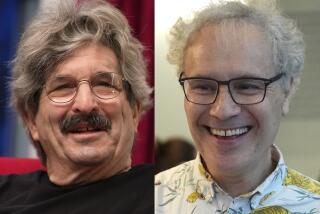Baruch Blumberg dies at 85; Nobel Prize winner who discovered hepatitis B virus
Dr. Baruch Blumberg, who received the 1976 Nobel Prize in physiology or medicine for discovering the hepatitis B virus, which causes severe liver disease and cancer, and who later developed the vaccine that protects against it, has died. He was 85.
Blumberg died Tuesday after apparently suffering a heart attack after delivering the keynote address at a NASA conference at the agency’s Ames Research Center at Moffett Field in Mountain View, near San Jose.
The isolation of the hepatitis B virus and development of a test for it were the first steps in the elimination of the virus from the U.S. blood supply, and the development of the vaccine led to a sharp decline in the incidence of both infections and liver cancer worldwide. Today it is one of the most widely used vaccines in the world and has saved millions of lives.
Blumberg stumbled on the virus by accident, stunning researchers who had spent decades searching for the cause of what was then called serum hepatitis.
In the 1960s, researchers knew that there were two types of “yellow jaundice,” or hepatitis, one of them transmitted through the gastrointestinal system in food and the other transmitted through blood. Those two are now called hepatitis A and B, and scientists know there are three other types as well, called C, D and E.
Between his third and fourth years of medical school, Blumberg had spent some time working at the isolated mining town of Moengo in what is now Suriname and was impressed by the widely different responses to infectious agents among different ethnic populations. He noted, for example, that miners born in Africa were much more susceptible to infections by the parasite that caused elephantiasis than those born in Indonesia or China.
That was the basis of his first scientific publication.
Blumberg began collecting blood samples from ethnic groups around the world to investigate a variety of problems, such as why some Africans have a higher susceptibility to sickle cell disease than others.
In 1963, he found an unknown substance, or antigen, in the blood of an Australian aborigine that reacted with immune molecules in the blood of a hemophilia patient in the United States.
In 1964, Blumberg noticed that a Down syndrome patient whose blood had previously shown no reaction to the antigen suddenly began reacting to it, and the patient subsequently developed hepatitis. After he observed the same sequence of events in another patient, he began testing for the “Australian antigen” in blood from serum hepatitis patients and found it was consistently present.
He subsequently showed that the Australian antigen was a molecule from the surface of the hepatitis B molecule, and it is now known as hepatitis B surface antigen.
But his 1967 paper reporting his discovery of the virus was rejected by the Annals of Internal Medicine, largely because he was a biochemist, not a virologist.
As he recalled in his autobiography prepared for the Nobel Prize committee, “We were outsiders not known to the main body of hepatitis investigators, some of whom had been pursuing their field of interest for decades. We were surprised by the hostility engendered among our new colleagues.”
But his results were soon replicated by other researchers, and the virus was quickly recognized as the cause of the disease. His development of a diagnostic test for the virus in blood soon led to the elimination of the majority of cases of hepatitis transmitted through blood. The 1989 identification of the hepatitis C virus by other researchers and development of a test for it led to elimination of the rest.
Blumberg then began working on a vaccine against the virus. Unfortunately, the virus could not be coaxed to grow in the laboratory in sufficient quantities to produce a vaccine. Blumberg and his colleague Dr. Irving Millman of the Fox Chase Cancer Center in Philadelphia prepared the first vaccine by isolating the hepatitis B surface antigen from patients with the disease.
Once again, their efforts were met by indifference, this time from pharmaceutical companies, which did not think such a vaccine could be profitable. Some of them were still not convinced that Blumberg’s purported virus even caused the disease. Eventually, however, Blumberg and Millman signed an agreement in 1976 with Merck & Co. to produce the vaccine.
The vaccine did not initially have wide distribution because of its high cost. But researchers eventually used recombinant DNA technology to manufacture the surface antigen in microorganisms, and universal vaccination programs became widespread.
Baruch Samuel Blumberg, known to his friends as Barry, was born July 28, 1925, in New York City. He enrolled at Union College in Schenectady, N.Y., but dropped out in 1943 to enlist in the Navy, becoming a deck officer on landing ships and eventually commanding one. In later years, he made several trips as a merchant seaman and held a license as a ship’s surgeon.
After the war, he returned to Union College and completed his undergraduate degree in physics. Blumberg enrolled in graduate school in mathematics at Columbia University, but, at his father’s urging, switched to medicine, earning his medical degree in 1951. He also earned a doctorate in biochemistry at Oxford University’s Balliol College.
After nearly two decades at Fox Chase, in 1989 he was elected Master of Balliol College at the University of Oxford, where he initiated one of Oxford’s first development programs to solicit funds from alumni, foundations, companies and others. Blumberg was the first scientist who was Master at Balliol, except for a 14th century alchemist.
Returning to the United States in 1997, he joined the Program on Human Biology at Stanford University. While there, Blumberg attended a NASA astrobiology workshop at Ames and became fascinated by the proceedings.
NASA’s then-director Dan Goldin subsequently recruited him to become the first head of the agency’s new Astrobiology Institute, which researched not only such questions as whether life can exist elsewhere in the universe, but also how it originated and evolved on Earth.
Blumberg was particularly interested in what came to be known as extremophiles, those organisms that can live in unusually hot and arid or exceptionally cold environments. He reasoned that they might provide a model for the types of life that could develop elsewhere.
But Blumberg did not expect to find intelligent life outside Earth, at least anytime soon. “If we found something more like a virus or a bacteria, that would be astounding enough,” he said in a 2002 interview.
An avid outdoorsman, he enjoyed middle-distance running in his early years, played squash, hiked and canoed and walked the mountains. He also was a co-owner of a farm in western Maryland that supplied beef for a local market. “Shoveling manure for a day is an excellent counterbalance to intellectual work,” he said.
Blumberg is survived by his wife of 57 years, the former Jean Liebesman; two sons; two daughters; and nine grandchildren.






